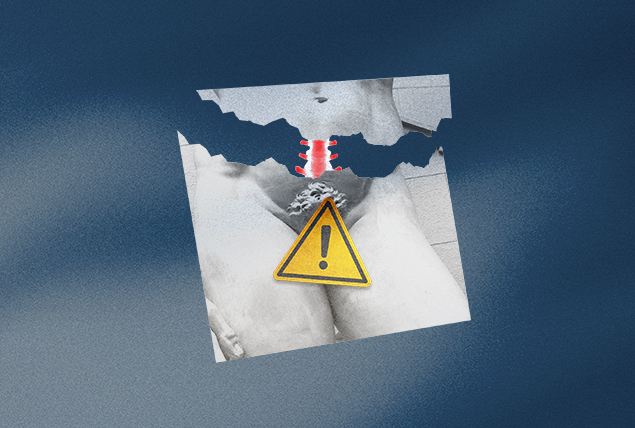What Happens to Sex After a Spinal Cord Injury?

Spinal cord injury (SCI), a traumatic, life-altering event, can pose a significant impact on a man's sexual health. Most men with SCI experience changes in sex after a spinal cord injury. SCI can disrupt communication between the brain and body, and one of the most common results is erectile dysfunction (ED), or the inability to achieve an erection firm enough for penetrative sexual intercourse.
Changes in erectile function depend on the level of SCI and whether it is complete or incomplete. A complete SCI is when a man loses all sensory and motor function below the level of injury. Paraplegia (paralysis of the lower body) and quadriplegia (paralysis of all four limbs) are the results of complete SCI.
Incomplete SCI involves partial damage in which the man has some sensory or motor function below the affected area.
Each man's sex life will be affected differently with SCI, so it is important to understand the different types of erections. Men have two kinds of erections: psychogenic and reflexogenic (or reflex).
These types of erections are controlled by different parts of the spinal cord, according to urologist Emad Ibrahim, M.D., the director of the Male Fertility Research Program at the University of Miami in Coral Gables, Florida.
The tenth thoracic vertebra (T10) to the second lumbar vertebra (L2) and sacral spinal nerve 2 (S2) to S4 are the areas of the spinal cord that control sexual function in men.
Reflexogenic erections
The reflexogenic erection requires some stimulation, and the nerve input that controls it is in the sacral region, S2 to S4, which is in the pelvis, around the penile area.
When the penis or the pelvic area is touched, the patient will get a reflexogenic erection. That is based solely on direct stimulation to the area. It could happen from touching the man's clothes when they are moving in the wheelchair or even from catheterization to empty their bladder.
In the case of reflexogenic, most men will say they can get an erection, just not always when they want one, and it may not get firm enough for sex or stay firm long enough.
"The issue with this erection is it is not maintained," Ibrahim said. "It happens, and it goes away instantaneously."
Reflexogenic erections are not related to any thoughts or visual or auditory stimulation. For example, looking at something erotic, or even having erotic thoughts, does not have an impact on this type of erection. The sacral part of the spine is intact and working, but it's not connected to the brain.
"Reflexogenic implies that there's a local tactile stimulation in the genital area that then reflexively, through ascending nerve routes to the spinal cord, and back out through descending nerve routes brings about an erection," said Arthur Louis Burnett, M.D., a professor of urology at Johns Hopkins School of Medicine in Baltimore, Maryland.
Because the nerves regulate blood flow to the penis for an erection, "anybody who has a spinal cord injury can have some disruption of that nerve signaling," Burnett said.
Psychogenic erections
Erections in which the stimulus originates in the brain are psychogenic erections. These erections rely mostly on inputs from the brain that are triggered by stimulation, such as visual stimulation (e.g., watching porn). This triggers the brain to send impulses to the spinal cord, causing an erection.
"This is totally not related to any stimulation by touch," Ibrahim explained. "It stimulates the senses, but it's not due to any direct stimulation."
This is the type of erection most men lose with SCI, "because it requires an intact nervous system in the thoracic area," Ibrahim said.
T11 to L2 is the area of the spinal cord responsible for psychogenic erections. When SCI is above this level, the message from the brain cannot get through the damaged part of the spinal cord.
"If erotic stimuli happened, the input needs to be relayed all the way down to the other system to maintain the erection," Ibrahim added. "But because of the nature of the injury, there's no communication and connection."
If the injury is below L2, the man may be able to get a psychogenic erection, but it may not be hard enough for penetration. If the spinal cord is severed, most men do not get the psychogenic erections. They would be more likely to get reflexogenic erections, Ibrahim said.
Very few SCI patients—typically men who have incomplete SCI or some remnant fibers—can get psychogenic erections, but that's very, very, rare, Ibrahim said.
Sex after a spinal cord injury also affects ejaculatory dysfunction
Ejaculation, the release of semen through the penis, requires T10 to L2 of the spinal cord to be intact. Men with SCI may experience anejaculation (the inability to ejaculate) or retrograde ejaculation (semen moves backward into the bladder).
About 90 percent of men with SCI develop some form of ejaculatory dysfunction, and only 10 percent can ejaculate by masturbation or during sex, according to research.
"The ejaculatory side of things can also be impacted by nerve injury because that truly is a nerve-regulated physiologic response," Burnett explained. "Typically, that involves neural circuits that lead to this ejaculatory reflex."
An orgasm is a recognition or perception at the brain level of having that ejaculatory reflex, he said.
SCI mainly has an impact on erection and ejaculation, "not so much the sexual interest or libido aspect," Burnett said.
"Usually, spinal cord injury doesn't necessarily change that," he said. "That's mainly a matter of hormones and sexual behavior that relate to that."


















